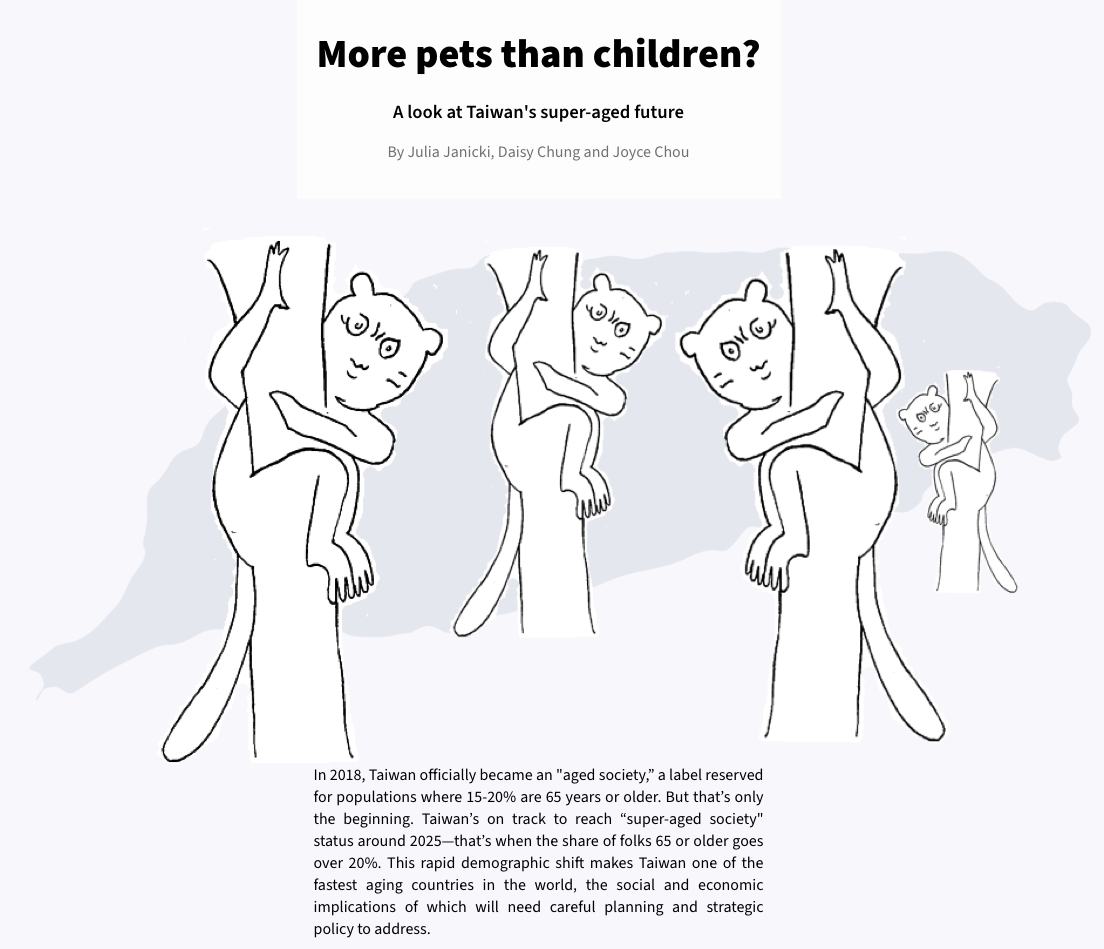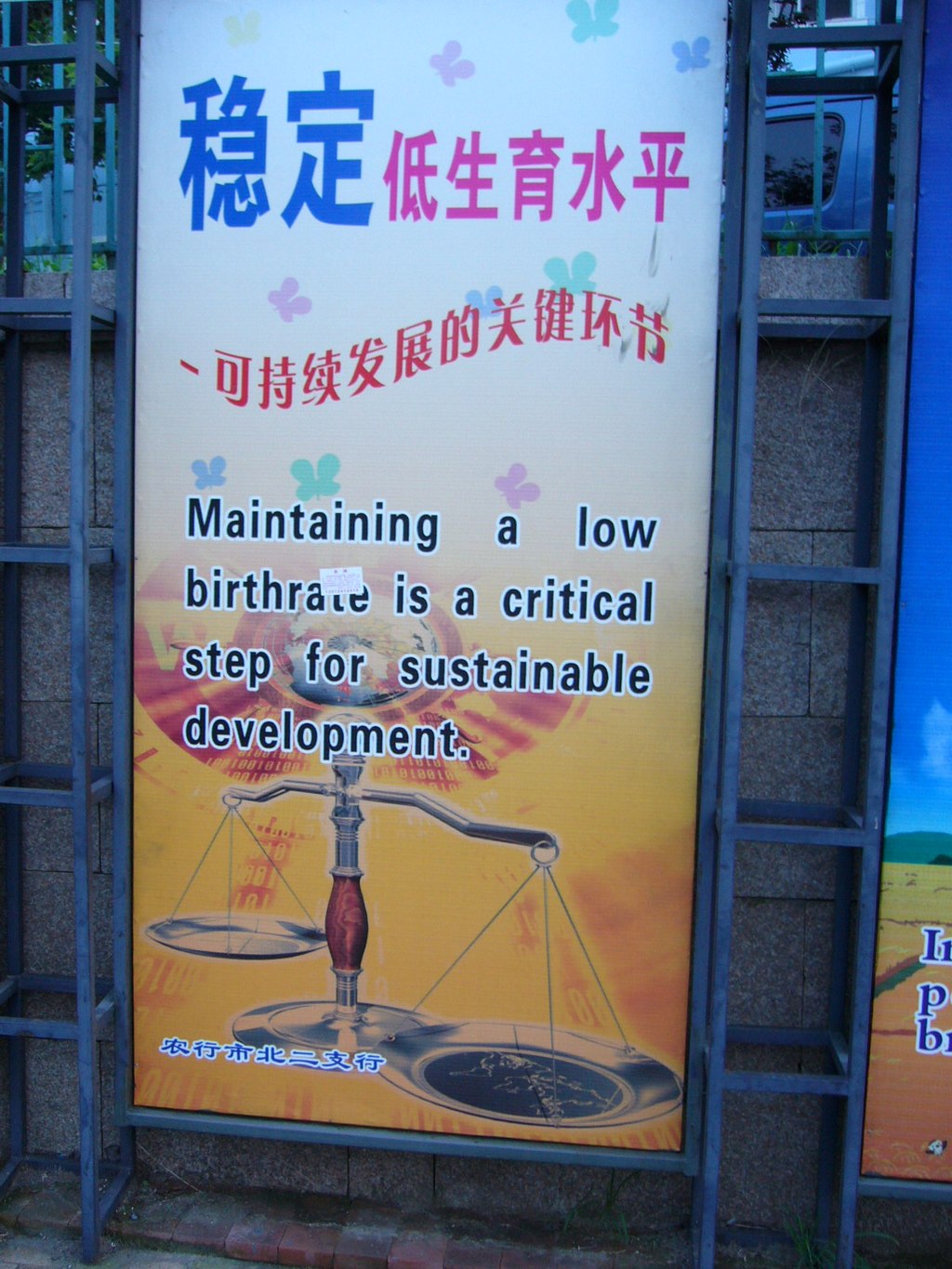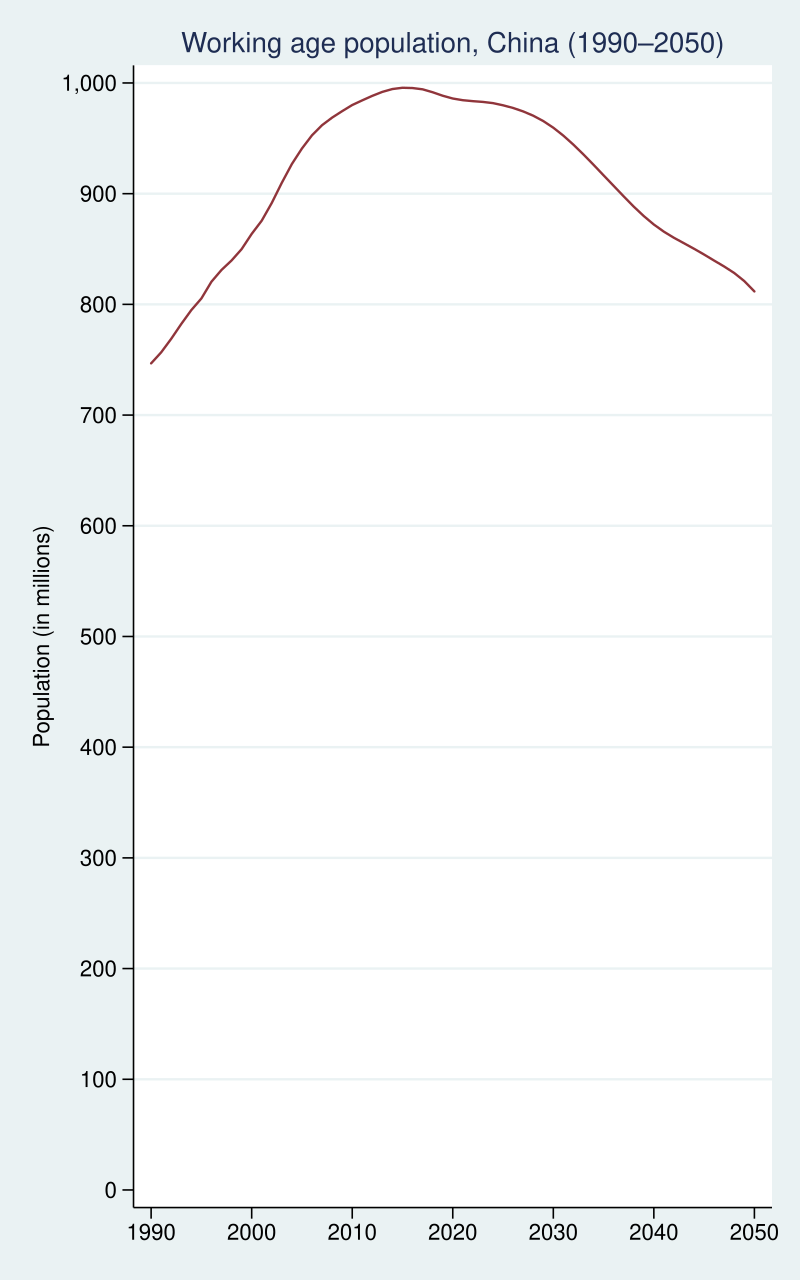
台湾の高齢化
Aging of Taiwan
☆ 台湾は急速に高齢化が進んでおり、出生率の低下と平均余命の延びにより、2025年には「超高齢社会」(65歳以上の人口が総人口の20%以上を占める社 会)になることが予測されている。65歳以上の人口が総人口の約7%に達したことで、台湾は正式に「高齢化社会」となった。出生率は、1964年に政府が 家族計画政策を導入して以来、すでに低下し始めていたが、1980年代と1990年代に大学がより普及するにつれて、さらに低下した。
https://taiwandatastories.com/taiwan-aging-population/
| Taiwan is rapidly
aging, projected to become a "super-aged society" (with over 20% of the
population aged 65 or older) by 2025, due to declining birth rates and
increased life expectancy. |
台湾は急速に高齢化が進んでおり、出生率の低下と平均余命の延びにより、2025年には「超高齢社会」(65歳以上の人口が総人口の20%以上を占める社会)になることが予測されている。 |
| Here's a more detailed look at Taiwan's aging population: Key Facts and Figures: Aging Society Threshold: Taiwan became an "aging society" (where 7% of the population is 65 or older) in 1993. Aged Society Threshold: It is expected to become an "aged society" (where 14% of the population is 65 or older) in 2017. Super-Aged Society: Taiwan is projected to become a "super-aged society" (where 20% or more of the population is 65 or older) by 2025. Rapid Aging: Taiwan's rate of population aging is among the fastest in the world. Factors Contributing to Aging: Increased Life Expectancy: Life expectancy has risen significantly in Taiwan. Declining Fertility Rates: Birth rates have plummeted, contributing to the aging population. |
台湾の高齢化について、より詳しく見てみよう。 主要な事実と数値: 高齢化社会の境界線:台湾は1993年に「高齢化社会」(人口の7%が65歳以上)となった。 高齢社会の境界線:2017年には「高齢社会」(人口の14%が65歳以上)になる見込みである。 超高齢社会:台湾は2025年までに「超高齢社会」(人口の20%以上が65歳以上)になることが予測されている。 急速な高齢化:台湾の高齢化率は世界でも最も速い部類に入る。 高齢化の要因: 平均余命の延長:台湾では平均余命が大幅に延びている。 出生率の低下:出生率は急落し、高齢化に拍車をかけている。 |
| Projected Future: By 2050, the share of the population aged 65 and above is projected to reach 35%. By 2039, seniors of 65 or above will account for 30 percent of Taiwan's total population. By 2070, the 65-or-older age group could reach 50% of Taiwan's population. |
将来の見通し: 2050年までに、65歳以上の人口の割合は35%に達すると予測されている。 2039年までに、65歳以上の高齢者は台湾の総人口の30%を占めることになる。 2070年までに、65歳以上の年齢層は台湾の人口の50%に達する可能性がある。 |
| Challenges and Impacts: Economic Strain: An aging population can lead to economic challenges, such as a shrinking workforce, reduced economic growth, and increased government spending on social welfare and healthcare. Fiscal Sustainability: The government's debt could become unsustainable in the future due to the large financial burden of supporting the elderly. Long-Term Care: Taiwan is struggling to meet the demand for long-term care for its elderly population. Social and Cultural Shifts: The aging population can lead to changes in social structures and cultural norms. |
課題と影響: 経済的負担: 人口の高齢化は、労働人口の減少、経済成長の鈍化、社会福祉や医療への政府支出の増加など、経済的な課題につながる可能性がある。 財政の持続可能性: 高齢者支援の財政負担が大きいため、政府債務は将来的に持続不可能になる可能性がある。 長期介護: 台湾は、高齢者人口の長期介護需要を満たすのに苦労している。 社会・文化の変化: 高齢化は社会構造や文化規範の変化につながる可能性がある。 |
| With
the proportion of people aged 65 or older reaching around 7% of the
total population, Taiwan officially became an “aging society.” Births
had already begun dropping since the government introduced a family
planning policy in 1964, but they dropped further as colleges became
more widespread in the '80s and '90s. |
65歳以上の人口が総人口の約7%に達したことで、台湾は正式に「高齢化社会」となった。出生率は、1964年に政府が家族計画政策を導入して以来、すでに低下し始めていたが、1980年代と1990年代に大学がより普及するにつれて、さらに低下した。 |
| https://taiwandatastories.com/taiwan-aging-population/ |
|
| Taipei,
Oct. 17 (CNA) Taiwan is set to become a "super-aged society" in 2025 as
projected, and its total population is projected to fall below 23
million in 2030 with a median age of 48.7, a report released by the
National Development Council (NDC) on Thursday showed. In its latest biennial report "Population Projections for the Republic of China (Taiwan): 2024-2070," the NDC estimated that Taiwan's total population will shrink from 23.4 million in 2024 to 14.97 million in 2070. The NDC based its estimate on the assumption that each child-bearing Taiwanese woman would give birth to an average of one child each in the future. A demographic bonus -- a condition in which the productive age population is more than the non-productive population -- will come to an end in 2028 as projected, the NDC said. By 2039, seniors of 65 or above will account for 30 percent of Taiwan's total population, the NDC said, warning that its demographic structure as a result of falling birth rates and longer life expectancy will continue deteriorating as population aging will keep on worsening over the long term. By 2070, the population aged 0-14 is projected to decrease by 1.7 million, and the population aged 15-64 will decline by 9.2 million. In contrast, the population aged 65 and over is expected to increase by 2.48 million. During the same time, the median age will grow from 45.1 in 2024 to 62.4 in 2070, with the potential support ratio -- the number of working-age individuals supporting each elderly person -- steadily declining from 3.6 for one this year to one for one in 2070. Government agencies should map out diverse measures to cope with the arrival of a super-aged society, including using artificial intelligence to create a new environment and new modes, the NDC said. (By Flor Wang and Pan Tzu-yu) Enditem/ASG by TaboolaSponsored Links |
台北 [2024年]10月17日(CNA)台湾は2025年に予測通りに「超高齢化社会」を迎え、2030年には総人口が2300万人を下回り、平均年齢は48.7歳になると、国家発展委員会(NDC)が木曜日に発表した報告書で示された。 国家発展委員会(NDC)が発表した最新の2年ごとの報告書「中華民国(台湾)人口予測:2024年~2070年」によると、台湾の総人口は2024年の2340万人から2070年には1497万人に減少すると推定されている。 NDCは、出産可能な台湾人女性が将来、平均して1人ずつ子供を産むという仮定に基づいて、この推定値を算出した。 NDCは、生産年齢人口が非生産年齢人口を上回る人口ボーナス(人口ボーナス)の状態は、予測通り2028年に終了するだろうと述べた。 2039年までに、65歳以上の高齢者が台湾の総人口の30パーセントを占めることになるだろうとNDCは述べ、出生率の低下と平均余命の延びによる人口構造の悪化は、人口の高齢化が長期的に悪化し続けるため、今後も継続するだろうと警告している。 2070年までに、0歳から14歳までの人口は170万人減少、15歳から64歳までの人口は920万人減少すると予測されている。一方、65歳以上の人口は248万人増加すると見込まれている。 同じ期間に、平均年齢は2024年の45.1歳から2070年には62.4歳に上昇し、高齢者1人を現役世代が何人で支えることができるかを示す潜在的な支援比率は、今年度の3.6人から2070年には1人となるなど、着実に低下していくと予想されている。 政府機関は、超高齢化社会の到来に備え、人工知能を活用して新たな環境や新たな形態を創出するなど、多様な対策を講じるべきであるとNDCは述べた。 (フロ・ワンとパン・ツーユーによる) 以上/ASG by TaboolaSponsored Links |
| https://focustaiwan.tw/society/202410170030 |
★参照:中国(本土)の高齢化("Aging of China" より)
China's population pyramid, 2023 to 2100, as projected by the United Nations in 2022
| China's population is aging
faster than almost all other countries in modern history.[1][2] In
2050, the proportion of Chinese over retirement age will become 39
percent of the total population according to projections. China is
rapidly aging at an earlier stage of its development than other
countries. Current demographic trends could hinder economic growth and
create challenging social issues in China.[1] In 1979, the Government of China established a controversial one-child policy aimed at curbing the high fertility rate.[3] With economic development, the provision of social services, and improved welfare conditions, life expectancy in China has also increased.[4] These two factors have directly contributed to China's aging population, which has significant ramifications on China's society, politics, and economy.[5][6][7] In October 2015, a two-child policy was introduced in an attempt to deal with the aging problem.[8] In May 2021, the Chinese government introduced the three-child policy in a further attempt to address the issue.[9] In July 2021, all family size limits as well as penalties for exceeding them were removed.[10] The National Bureau of Statistics of China reported that total Chinese population decreased by 2.08 million in 2023, with the death rate reaching the highest level since 1974.[11] |
中国の人口の高齢化は、近代史上のほとんどの国々よりも急速に進んでい
る。[1][2]
予測によると、2050年には定年退職年齢を超えた中国人の割合は総人口の39%に達する。中国は他の国々よりも早い段階で急速に高齢化が進んでいる。現
在の人口動態は中国の経済成長を妨げ、社会問題を引き起こす可能性がある。[1] 1979年、中国政府は出生率の高騰を抑制することを目的とした物議を醸した「一人っ子政策」を導入した。[3] 経済発展、社会サービスの提供、生活水準の向上に伴い、中国の平均余命も伸びている。[4] これら2つの要因が中国の人口の高齢化に直接的に寄与しており、それは中国の社会、政治、経済に重大な影響を及ぼしている。 [5][6][7] 2015年10月には、高齢化問題に対処するための試みとして、2人目の子供を持つことを認める政策が導入された。[8] 2021年5月には、中国政府がさらなる試みとして3人目の子供を持つことを認める政策を導入した。[9] 2021年7月には、家族の人数制限およびそれを超えた場合の罰則がすべて撤廃された。[10] 中国国家統計局は、2023年の中国の総人口は208万人減少したと報告し、死亡率は1974年以来最高水準に達したと発表した。[11] |
| Overview See also: Demographics of China Demographics of China Death rate 7.1 per 1,000 people[12] Life expectancy 77.47 years Fertility rate 1.3 births per woman[13] China's demographic information, 2020 From 1950 to 2020, the total fertility rate in China dropped from 6.11 to 1.3 births per woman.[13] The mortality rate also decreased, from 22.2 to 7.1 per 1,000 people.[12] Life expectancy rose from 44.6 to 77.47 years from 1950 to 2020, and is expected to reach about 80 years in 2050.[14] In 2018, 249.49 million people over 60 years old constituted 17.9 percent of the total population.[15] Chinese state media reported the country's total fertility rate dropped to 1.09 in 2022.[16] |
概要 参照:中国の人口統計 中国の人口統計 死亡率 1,000人あたり7.1人[12] 平均余命 77.47年 出生率 女性1人あたり1.3人の出生数[13] 中国の人口統計情報、2020年 1950年から2020年の間に、中国の合計特殊出生率は女性1人あたり6.11人から1.3人に減少した。死亡率も減少しており、1,000人あたり 22. 1,000人あたり22.2人から7.1人に減少した。[12] 平均余命は1950年から2020年の間に44.6歳から77.47歳に延び、2050年には約80歳に達すると予測されている。[14] 2018年には、60歳以上の人口は2億4949万人となり、総人口の17.9%を占めた。[15] 中国の国営メディアは、同国の合計特殊出生率が2022年に1.09まで低下したと報じた。[16] |
| Causes China's aging population is caused by a low birth rate together with prolonged human life expectancy. Low fertility rates One-child policy Main article: One-child policy  China used the one-child policy to stabilize fertility levels In order to suppress excessive population growth, the one-child policy was introduced in 1979.[17] The enforcement methods include financial penalties, widespread use of various contraceptive methods, as well as more severe forced abortion and sterilization. As a result, birth rates and population growth rates have drastically decreased.[3][17] Previously, the fine is so-called "social maintenance fee" and it is the punishment for the families who have more than one child. According to the policy, the families who violate the law may bring the burden to the whole society. Therefore, the social maintenance fee will be used for the operation of the basic government.[18] Reproductive health of couples With economic growth and social development, increasing smoking, alcohol use, unhealthy diets, and psychological stress have an effect on lowering the fertility rates of couples.[19] Surging pollution in China also has an impact on male sperm count, which has been declining since the 1970s.[citation needed] At the Chinese University of Hong Kong, a team of scientists studied the sperms from approximately 6,500 men and found a "strong correlation" between high levels of air pollution and "abnormal sperm shape".[20] Researchers point out that many particulate matter components are associated with sperm damage in experimental studies.[20] Exposure to air pollutants may cause free radicals to exceed body's regulation ability, adversely altering biologically relevant molecules such as DNA and triggering human diseases.[21] These conditions may be associated with a significant number of infertile couples, lowering the fertility rate. Cultural impact China's sex ratio is the most skewed in the world.[22] The country's ratio of males to females is skewed 3% to 4% higher towards males.[17] In the traditional, patriarchal society, many Chinese people believed that men were more important than women.[17] This mindset has continued to be prevalent in modern China, especially in rural areas, resulting in high female fetal abortion rates and even female infanticide.[17] The imbalance in sex ratio has led to a decrease in marriage rates and birth rates in China. Extension of human life span The improvements in social welfare and the medical system have prolonged people's life span. Since 1949, the general health of the Chinese people has greatly improved, and the life expectancy has increased by about 30 years, from 44.6 to 75.3 years from 1950 to 2015. It is expected to reach approximately 80 years in 2050.[14] The minimum income security in rural areas has been expanded and is covering more than 50 million residents in poor areas.[23] The Chinese government has unified the welfare systems of urban and rural migrants, and the pension system covers nearly 700 million people.[23][24] Despite the improvement of China's social welfare system, there are still huge inequalities in health between urban and rural areas.[24] Compared with urban peers, the number of medical service providers for rural residents is significantly reduced, and the utilization rate of facilities is low, resulting in their poor health.[24] Since the late 1990s, three new medical insurance systems have been established by the government to provide more health care services.[25] In 2009, urban and rural health insurance reforms achieved greater coverage.[25] More advanced medical techniques have reduced the prevalence of diseases and increased survival.[26] |
原因 中国の人口の高齢化は、出生率の低下と平均余命の長期化によって引き起こされている。 低出生率 一人っ子政策 詳細は「一人っ子政策」を参照  中国は出生率の安定化を図るために一人っ子政策を実施した 過剰な人口増加を抑制するために、1979年に一人っ子政策が導入された。[17] 施行方法は、罰金、各種避妊方法の普及、より厳しい中絶や不妊手術などがある。その結果、出生率と人口増加率は大幅に減少した。[3][17] 以前は、いわゆる「社会養育費」と呼ばれる罰金が、子供を二人以上持つ家庭に科せられていた。この政策によると、法律に違反した家庭は社会全体に負担をか ける可能性がある。そのため、社会扶養料は基本的な政府運営のために使用される。 夫婦の生殖保健 経済成長と社会発展に伴い、喫煙、飲酒、不健康な食生活、心理的ストレスの増加が夫婦の出生率低下に影響を与えている。 [19] 中国における急増する公害は、1970年代以降減少傾向にある男性の精子数にも影響を与えている。[要出典] 香港中文大学では、科学者チームが約6,500人の男性の精子を調査し、大気汚染の深刻な地域では「精子の形状異常」が「強く相関している」ことを発見し た。[20] 研究者たちは、実験研究において、多くの粒子状物質の成分が精子の損傷と関連していることを指摘している。[20] 大気汚染物質への曝露は、フリーラジカルが身体の調整能力を超える原因となり、DNAなどの生物学的に関連する分子に悪影響を与え、人間の病気を引き起こ す可能性がある。[21] これらの状況は、不妊症の夫婦の相当数に関連している可能性があり、出生率を低下させている。 文化的な影響 中国の性比は世界で最も偏っている。[22] 同国の男女比は、男性が3%から4%高い。[17] 伝統的な家父長制社会では、多くの中国人が男性の方が女性よりも重要であると考えていた。[17] この考え方は現代の中国でも、特に農村部で根強く残っており、その結果、女性胎児の中絶率が高く、女児殺しさえも発生している。 [17] 男女比の不均衡は、中国の婚姻率と出生率の低下につながっている。 人間の寿命の延長 社会福祉と医療制度の改善により、人々の寿命が延びた。1949 年以降、中国国民の一般的な健康状態は大幅に改善し、平均余命は 1950 年から 2015 年の間に 44.6 歳から 75.3 歳へと約 30 歳延びた。2050年には約80歳に達すると予想されている。[14] 農村部の最低所得保障は拡大され、貧困地域の5,000万人以上の住民をカバーしている。[23] 中国政府は都市部と農村部の移住者の福祉制度を統一し、年金制度は7億人近くをカバーしている。[23][24] 中国の社会福祉制度の改善にもかかわらず、都市部と農村部の保健状態には依然として大きな格差がある。都市部の住民と比較すると、農村部の住民に対する医 療サービス提供者は大幅に少なく、施設の利用率も低いため、農村部の住民の健康状態は良くない。1990年代後半以降、政府はより多くの医療サービスを提 供するために、新たに3つの医療保険制度を設立した。 2009年には、都市部と農村部の医療保険改革により、より広範な適用が実現した。[25] より高度な医療技術により、疾病の発生率が低下し、生存率が上昇した。[26] |
| Impacts The demographic trend of aging population has social, political and economic ramifications in China. The growth of the elderly population has increased the dependency ratio and the prevalence of many chronic diseases.[5] Aging society has also brought about changes in public policy.[6] The weakening of the labor force has negative impacts on China's economic growth and development, which was originally driven by the labor market.[7] Social Rapid aging could create only a few challenging social problems and does not increase the risk of social instability in China.[1] Due to the lower fertility rate and extension of the human life span, the population in China is aging faster than almost all other countries.[1][2] In 2050, the proportion of Chinese over retirement age will become 39 percent of the total population.[27] At that time, its dependency ratio will rise to 69.7%, almost twice as high as that in 2015, which was about 36.6%.[27] The higher dependency ratio is associated with the greater pressure placed on those who are working to support the rest of the population. Even if the Chinese government provides part of the financial support for the elderly through social welfare, such as pensions and public welfare homes, there are still many elderly people in China who are unable to be taken care of.[27] In 2015, there were, on average, 27 beds per 1,000 elderly in nursing homes in China, far fewer than those in the United States or Germany.[27] The aging population in China has increased the incidence and types of chronic diseases. Chronic diseases include four basic types: cardiovascular diseases, cancer, respiratory diseases, and diabetes.[28] There are nearly 300 million chronic patients in China, half of whom are over 65 years old.[28] During aging, many cellular and molecular events break down and eventually lead to a variety of chronic diseases, such as coronary heart diseases (CHD). The number of CHD incidents and deaths in China will increase dramatically from 2010 to 2029; among Chinese adults aged 35–84, a 64% increase in CHD occurrences is predicted between 2020 and 2029.[5] Political A large number of the elderly population has increased the pressure on the Chinese government to allocate the pensions and make social welfare more accessible.[6] The lack of conventional financial infrastructure and the extent of the aging population make it difficult for China to provide a holistic solution.[6] Even at an economic growth rate of 8 percent, pension spending is growing much faster at a rate of 15 percent per year.[6] Pension expenditure increased by 11.6% in 2016, reaching 2.58 trillion yuan, with a shortfall of 429.1 billion yuan, requiring government subsidies.[29] Since the establishment of the pension system, China has been paying the income of retirees with the contribution of the working population.[29] As more people retire and fewer people enter the labor market, the gap between income and expenditure will continue to widen.[29] China's Working Committee on Ageing suggested that the inclusion of improved care services for the elderly in the national development road-map would be a key measure for the top leadership to cope with population aging.[30] The elderly care service market provides more opportunities for private capital and non-governmental organizations so that the elderly can have more service choices.[30] In 2022, Peking University and Lancet established a commission on healthy aging in China.[31]: 162 The Commission's purpose is to re-focus the debate on aging not just on the risks but on opportunities through "unleashing the intellectual and vocational capacities of the older population and the whole of Chinese society."[31]: 162 Also in 2022, the Fudan Institute on Aging was established as a state-level think tank aimed at developing what it describes as Chinese solutions for addressing the problems of aging and Chinese wisdom for coping with an aging society.[31]: 164 Neighborhood committees of the Chinese Communist Party are typically staffed by older volunteers.[32]: 118 |
影響 高齢化人口の人口動態は、中国において社会的、政治的、経済的な影響を及ぼしている。高齢者人口の増加は、依存率を高め、多くの慢性疾患の蔓延を招いてい る。[5]高齢化社会は、公共政策の変化ももたらしている。[6]労働力の弱体化は、労働市場によってもともと牽引されていた中国の経済成長と発展に悪影 響を及ぼしている。[7] 社会 急速な高齢化は、いくつかの困難な社会問題を引き起こす可能性があるが、中国社会の不安定化リスクを高めるものではない。 出生率の低下と平均寿命の延長の影響により、中国の人口の高齢化はほぼすべての国よりも速いペースで進んでいる。2050年には、定年退職年齢を超えた中 国人の割合は総人口の39%に達する。 [27] その時点での扶養比率は69.7%に上昇し、2015年の約36.6%と比較するとほぼ2倍に達する。[27] 扶養比率の上昇は、残りの人口を支えるために働く人々への負担増につながる。中国政府が年金や公共福祉施設などの社会福祉を通じて高齢者への財政支援の一 部を提供しているとしても、中国には依然として介護を受けられない高齢者が数多くいる。[27] 2015年には、中国の介護施設における高齢者1,000人当たりのベッド数は平均27床であり、米国やドイツのそれと比べるとはるかに少ない。[27] 中国の人口の高齢化は、慢性疾患の発生率と種類を増大させている。慢性疾患には、心血管疾患、癌、呼吸器疾患、糖尿病の4つの基本的な種類がある。 [28] 中国には約3億人の慢性疾患患者がおり、その半数は65歳以上である。[28] 高齢化に伴い、多くの細胞および分子レベルの事象が崩壊し、最終的に冠動脈性心臓疾患(CHD)などのさまざまな慢性疾患につながる。中国における冠状動 脈性心臓疾患(CHD)の発生件数および死亡者数は、2010年から2029年にかけて劇的に増加する見通しである。35歳から84歳までの中国人の成人 では、2020年から2029年の間にCHDの発生件数が64%増加すると予測されている。[5] 政治 高齢者の人口が大幅に増加したことで、中国政府は年金の配分と社会福祉の充実を迫られている。[6] 従来の金融インフラの欠如と高齢化の進行により、中国は包括的な解決策を提供することが困難になっている。 [6] 経済成長率が8パーセントであっても、年金支出は年間15パーセントというはるかに速いペースで増加している。[6] 2016年の年金支出は11.6%増加し、2兆5800億元に達し、4291億元の不足が生じ、政府からの補助金が必要となった。[29] 年金制度が設立されて以来、中国は現役世代の拠出金で退職者の収入を賄ってきた。[29] 退職者が増え、労働市場に参入する人が減るにつれ、収入と支出の差はさらに拡大するだろう。 [29] 中国の「高齢化に関する作業委員会」は、高齢者向けケアサービスの改善を国家開発ロードマップに盛り込むことが、高齢化に対処するための指導部による主要 な対策であると提言した。[30] 高齢者向けケアサービス市場は、民間資本や非政府組織に多くの機会を提供し、高齢者がより多くのサービスを選択できるようにする。[30] 2022年、北京大学とランセットは、中国における健康な高齢化に関する委員会を設立した。[31]:162 委員会の目的は、高齢化に関する議論をリスクだけでなく、機会にも焦点を当てることである。「高齢者と中国社会全体の知的・職業的能力を解き放つ」こと で、[31]:162 162 また2022年には、高齢化問題への対応策として「中国式ソリューション」を開発し、高齢化社会への対処法として中国の知恵を活用することを目的とした国 家レベルのシンクタンクとして、復旦大学高齢化研究所が設立された。[31]:164 中国共産党の隣組は通常、高齢のボランティアによって構成されている。[32]:118 |
| Geopolitical China's aging population could hinder economic growth, create challenging social problems, and limit its capabilities to act as a new global hegemon.[1][33][34][35] Ryan Hass of the Brookings Institution said, "China is at risk of growing old before it grows rich, becoming a graying society with degrading economic fundamentals that impede growth." He went on to say, "The working-age population is already shrinking; by 2050, China will go from having eight workers per retiree now to two workers per retiree. Moreover, it has already squeezed out most of the large productivity gains that come with a population becoming more educated and urban and adopting technologies to make manufacturing more efficient."[36] Nicholas Eberstadt, an economist and demographic expert at the American Enterprise Institute, said that current demographic trends will overwhelm China's economy and geopolitics, making its rise much more uncertain. He said, "The age of heroic economic growth is over."[37] Brendan O'Reilly, a guest expert at Geopolitical Intelligence Services, wrote, "A dark scenario of demographic decline sparking a negative feedback loop of economic crisis, political instability, emigration and further decreased fertility is very real for China".[38][39] Economic Labor force  A 2021 World Bank projection of the working-age population in China, 1990–2050.[40][41] Since economic expansion is the sum of input factor growth and productivity growth, it will require a substantial increase in labor productivity to sustain the same top-line growth as the population ages.[42] China's aging population has led to a contraction of the labor force that induces a slowing economic growth.[7] In 2017, China's total working-age population (aged between 15 and 64) was 988.3 million, which dropped by a large margin of 70 million from the end of 2016.[43] By 2024, China had one of the lowest retirement ages among major world economies, with many working women eligible for retirement at 50 and men at 60.[31]: 167 China is urged to raise the legal age of retirement to cope with the problem of a reduced labour force.[7] In 2016, the Chinese government announced plans to gradually raise the retirement age from 50 years old to over 60 years old.[44] It may expand productivity and improve the sustainability of national pension accounts by improving the level of education and skills of Chinese workers to make up for the gap from the decreasing proportion of the working-age population.[44][7] In September 2024, with rising concerns about pension insolvency and a declining workforce, China decided to increase its retirement age across the board, increasing the age of retirement from 60 to 63 for male workers, 55 to 58 for female white collar workers, and 50 to 55 for female blue collar workers.[45][46] Another measure China has employed to mitigate an aging workforce is to improve labor force quality, boosting university enrollment by seven times from 1999 to 2018 in China.[47] Aging in China has affected women's labor force participation to a certain extent. A large proportion of grandparents in China provide the free services of raising grandchildren for their children. This constitutes a main reason why women decide to stay in the labor market.[44] China has a relatively high female labor force participation rate of 61.5%.[44] Allocation of government funds An increase in the number of retirees and a decrease in the number of taxpayers will affect the government's allocation of funds.[27] The expansion of the elderly ratio forces the government to support them by providing pensions and expanding social welfare, which will affect the government budget. China's pension funds accounted for nearly 70% of China's social security income in 2017.[48] Without subsidies from the central government, many local pension funds will run into a deficit, of which the total is expected to rise from 234 billion yuan to 534 billion yuan in 2022.[48] |
地政学的な 中国の高齢化は、経済成長を妨げ、困難な社会問題を生み出し、新たな世界覇権国としての能力を制限する可能性がある。[1][33][34][35] ブルッキングス研究所のライアン・ハスは、「中国は豊かになる前に高齢化が進み、経済基盤が弱体化して成長を妨げる高齢化社会になるリスクがある」と述べ た。さらに、「生産年齢人口はすでに減少しており、2050年には、退職者1人に対して8人の労働者がいる現状から、退職者1人に対して労働者は2人とな るだろう。さらに、人口の教育水準や都市化が進み、製造効率を高める技術が導入されることで得られるはずの生産性向上のほとんどは、すでに実現されてい る」と述べた。[36] アメリカン・エンタープライズ研究所の経済学者で人口統計学の専門家であるニコラス・エバスタット氏は、現在の人口動態の傾向が中国の経済と地政学を圧倒 し、その台頭をより不確実なものにするだろうと述べた。「英雄的な経済成長の時代は終わった」と彼は述べた。[37] ジオポリティカル・インテリジェンス・サービスのゲスト専門家であるブレンダン・オライリーは、「人口減少が経済危機、政治的不安定、移民、さらなる出生 率低下という負のフィードバックループを引き起こすという暗いシナリオは、中国にとって非常に現実的なものだ」と書いた。[38][39] 経済 労働力  1990年から2050年における中国の生産年齢人口に関する2021年の世界銀行予測。[40][41] 経済成長は投入要素の成長と生産性成長の合計であるため、人口の高齢化に伴う売上高の成長を維持するには、労働生産性を大幅に向上させる必要がある。 [42]中国の人口の高齢化は労働力の減少につながり、経済成長の鈍化を招いている。 [7] 2017年には、中国の生産年齢人口(15歳から64歳)の総数は9億8830万人となり、2016年末から7000万人も大幅に減少した。[43] 2024年までに、中国は主要な世界経済の中で最も定年退職年齢が低い国のひとつとなり、多くの働く女性は50歳、男性は60歳で定年退職の対象となっ た。[31]:167 中国は労働力人口の減少という問題に対処するために、定年退職の法定年齢を引き上げるよう促されている。 [7] 2016年、中国政府は段階的に定年を50歳から60歳以上に引き上げる計画を発表した。[44] 労働人口の割合が減少していることによるギャップを埋めるために、中国の労働者の教育水準と技能を向上させることで、生産性を拡大し、国民年金の持続可能 性を改善できる可能性がある。 [44][7] 2024年9月、年金の支払い不能と労働人口の減少に対する懸念が高まる中、中国は定年を一律に引き上げることを決定し、男性労働者の定年を60歳から 63歳に、女性ホワイトカラー労働者の定年を55歳から58歳に、女性ブルーカラー労働者の定年を50歳から55歳に引き上げた。 [45][46] 労働人口の高齢化を緩和するために中国が採用したもう一つの対策は、労働力の質を向上させることであり、1999年から2018年にかけて中国の大学への 入学率を7倍に引き上げた。[47] 中国の少子高齢化は、女性の労働力参加に一定の影響を与えている。中国では祖父母世代が孫の育児を無償で担う割合が大きい。これが女性が労働市場にとどまる主な理由となっている。[44] 中国の女性の労働力参加率は61.5%と比較的高い。[44] 政府資金の配分 退職者の増加と納税者の減少は、政府の資金配分に影響を与える。[27] 高齢者の割合の拡大は、政府に年金の支給や社会福祉の拡充による高齢者支援を余儀なくさせ、政府予算に影響を与える。2017年には、中国の年金基金が中 国の社会保障収入の70%近くを占めていた。[48] 中央政府からの補助金がなければ、多くの地方年金基金が赤字に陥り、その総額は2022年には2340億元から5340億元に増加すると予想されている。 [48] |
| Government policies In order to alleviate the population aging in China, the Chinese government has relaxed its child limitation policies. Under the amended Article 18 of China's Population and Family Planning Law, every married couple is allowed to have up to three children.[49] Two-child policy Main article: Two-child policy § People's Republic of China In October 2015, the national government relaxed the one-child policy into the two-child policy.[8] China had been taking gradual measures to eliminate the one-child policy. In 2009, if both parents were only children, they were allowed to have two children. In 2014, most provinces in China further relaxed their policies, allowing families to have two children if one of the parents was an only child.[47] However, since the implementation of the two-child policy, there has been no significant improvement in China's population aging.[50] It was expected that the effect of the policy will not be significant until two decades later.[51] After the relaxation of the one-child policy, 17.9 million babies were born in 2016, an increase of 1.3 million over the previous year, but only half of what was expected.[50] In 2017, births fell to 17.2 million, far below the official forecast of more than 20 million.[50] Three-child policy Main article: Three-child policy In May 2021, the Chinese government introduced the three-child policy in a further attempt to address the issue.[9] However, the improvement has been limited since the implementation of the policy, largely due to the impact of COVID-19, economic uncertainty and people's current struggles in supporting children as well as old parents.[52] Policy support for the elderly Article 28 of the 1980 New Marriage Law formalizes the obligations of supporting grandparents for those "who can afford it[.]"[53] Reinforcing this responsibility, the 1985 Inheritance Law provides that if a parent dies without a will, the disposition of property is applied heavily in favor of children who cared for the deceased.[53] The 1996 Law to Protect the Rights and Interests of the Elderly (laonianren quanyi baozhang fa) obligates children to provide for their elderly (defined as aged sixty or greater) parents, including providing housing, living costs, and health care.[53] Article IV prohibits discriminating against, maltreating, and forsaking the elderly.[53] In 2009, China established a state-sponsored elderly insurance program.[54]: 64 To address the aging of China's population, the Fourteenth Five Year Plan (covering 2021–2025) seeks to expand healthcare and retirement system initiatives.[55]: 201 |
政府の政策 中国の高齢化を緩和するために、中国政府は子供の制限政策を緩和した。中国の人口と家族計画法の改正された第18条に基づき、すべての夫婦は3人までの子供を持つことが認められている。[49] 2人子供政策 詳細は「2人子供政策」の項目を参照 2015年10月、中国政府は一人っ子政策を二人っ子政策へと緩和した。[8] 中国は段階的に一人っ子政策を廃止する措置を講じてきた。2009年には両親がともに一人っ子の場合、2人の子供を持つことが認められた。2014年に は、中国のほとんどの省がさらに政策を緩和し、両親のどちらかが一人っ子の場合、2人の子供を持つことが認められた。[47] しかし、2人目の子供を持つことが認められてから、中国の人口の高齢化に目立った改善は見られていない。[50] この政策の効果が顕著に現れるのは、20年後になるだろうと予測されている。 [51] 1人っ子政策の緩和後、2016年に生まれた赤ちゃんは1790万人で、前年より130万人増加したが、期待されていた半分にとどまった。[50] 2017年には出生数は1720万人に減少し、2000万人を超えるという公式予測を大幅に下回った。[50] 3人っ子政策 詳細は「3人っ子政策」を参照 2021年5月、中国政府は問題に対処するためのさらなる試みとして、3人っ子政策を導入した。[9] しかし、政策実施以来、改善は限定的であり、その主な原因は新型コロナウイルス感染症(COVID-19)の影響、経済的不確実性、子供や高齢の親を扶養 することに対する人々の現在の苦労である。[52] 高齢者に対する政策支援 1980年の新婚姻法第28条では、「経済的に余裕のある人」に対して祖父母を扶養する義務を正式に定めている[53]。この責任を強化するために、 1985年の相続法では、親が遺言を残さずに死亡した場合、財産の処分は亡くなった親の世話をした子供たちに大きく有利になるよう適用されると規定してい る[53]。 1996年の「高齢者の権益保障に関する法律(laonianren quanyi baozhang fa)」は、子供たちに60歳以上の高齢者である親の住居、生活費、保健ケアの提供を含む扶養を義務付けている。[53] 第4条では、高齢者に対する差別、虐待、見捨てを禁止している。[53] 2009年、中国は国が後援する高齢者保険制度を創設した。[54]: 64 中国の人口の高齢化に対処するため、第14次5ヵ年計画(2021年から2025年まで)では、医療と退職制度のイニシアティブを拡大することを目指している。[55]: 201 |
| Aging of Japan Aging of South Korea |
日本の高齢化 韓国の高齢化(→高齢化社会のデザインに関する韓日比較研究) |
| https://en.wikipedia.org/wiki/Aging_of_China |
リ ンク
文 献
そ の他の情報
CC
Copyleft, CC, Mitzub'ixi Quq Chi'j, 1996-2099
☆
 ☆
☆